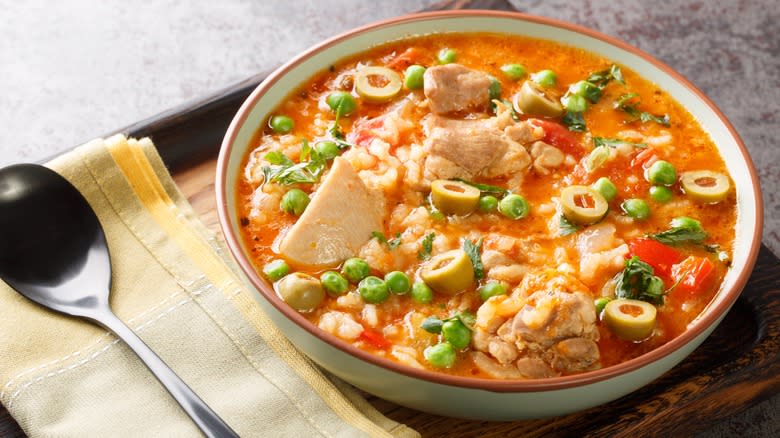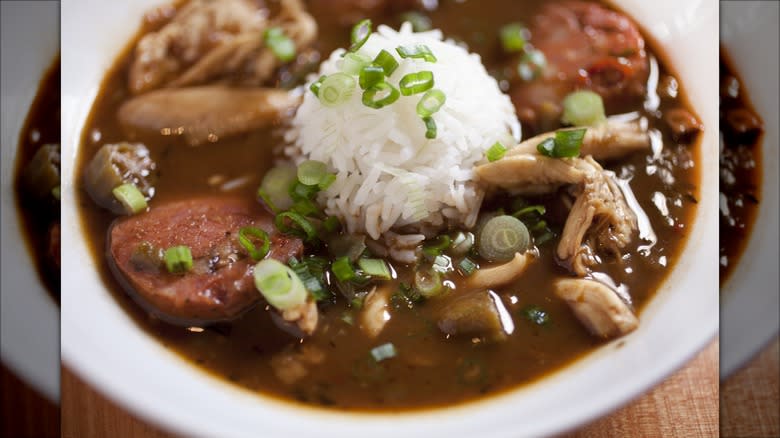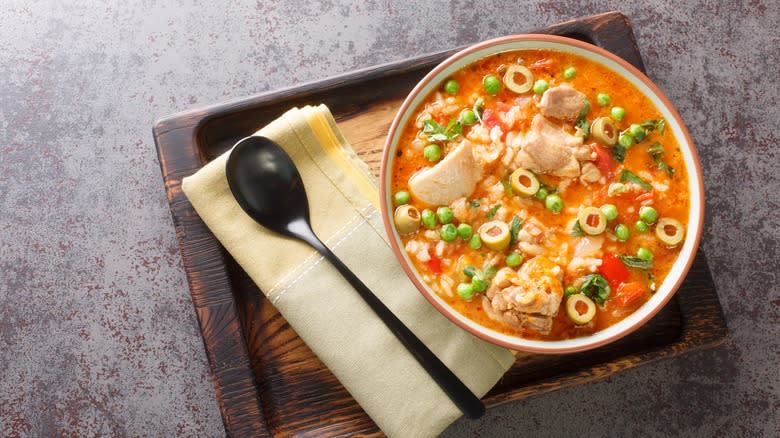The Key Differences Between Asopao Soup And Gumbo

New Orleans cuisine is among the finest in the world -- absolutely no one can deny that -- and one of the region's signature dishes is gumbo, a stew made using a thick, dark roux and a mix of meat, vegetables, and seafood. What combination you use is up to you; one of gumbo's most appealing qualities is its versatility. Whatever your dietary restrictions, it's not hard to make gumbo work for you -- just as long as okra is in there somewhere.
But gumbo isn't the only tasty, dark stew out there among global cuisines. Another is asopao, a Puerto Rican dish you might not be familiar with but one that you're going to want to try. So, what's the difference between the two? Quite a lot, it turns out: The ingredients vary significantly, the consistencies are different, and the seasoning is pretty much nothing alike. Plus, they have roots in entirely separate cultures. Beyond the fact that they're both hearty stews, gumbo and asopao are extremely different from each other.
Read more: 13 Tips To Make Your Shrimp Taste So Much Better
Gumbo's Roots Are Solidly West African

The history of gumbo mirrors that of New Orleans itself: An incredible fusion of cultures and cuisines from around the world, ranging from French and Spanish to Native American, Chinese, and Italian. When it comes to gumbo specifically, there's one cuisine that has an outsized influence: West African. The key component of gumbo is okra, a plant that isn't native to the Americas. It was brought to French Louisiana by enslaved West Africans, who used it as a thickener in stews. Indeed, "gumbo" is itself a shortening of a word that means "okra" in several Bantu languages: "Ki ngombo."
The progenitor of gumbo thus featured okra heavily, although the stew we know today is a fusion of all of Louisiana's disparate cuisines. Gumbo's European contributions namely include the signature dark roux used to thicken the stew, while the original West African creation would have been thickened purely with okra. The whole point of modern gumbo is that you can put whatever you want in it so long as it has okra, as well as that thick, dark, hearty quality. It usually features trinity vegetables -- celery, bell peppers, and carrots -- and filé powder, which is a Native American mixture of dried, ground sassafras leaves. Shellfish is a common component, particularly the stock, which is most often a seafood-based one. From there, though, you can get creative with it, especially concerning proteins.
Asopao Is A Chicken And Rice Stew

Puerto Rican food is an underrated cuisine, and asopao fits right into that. But, it's not a whole lot like gumbo other than the fact that both are hearty stews.
The visual differences are easy enough to spot -- asopao isn't made with the dark roux that gives gumbo its striking appearance. It does typically feature trinity vegetables but doesn't involve okra. The seasoning is wildly different, with asopao typically making use of achiote oil, sazón seasoning, and adobo seasoning. It's typically made with chicken stock, and that's where we come to the biggest difference: The signature components of asopao are chicken and rice. Gumbo can theoretically feature both those things, but not only are they optional, the rice is treated more as a side component than as the star of the dish. You also can't make asopao without sofrito, a blend of onions, peppers, garlic, and herbs that you won't often find in a gumbo.
Asopao also ofrequently makes use of pimento-stuffed olives, as well as flavorings like cilantro and lime, none of which you're ever likely to see in a gumbo. There's still plenty of versatility to asopao -- it's sometimes claimed that every family has their own recipe -- but while it may share some traits with gumbo, it is distinct from it.
Read the original article on Daily Meal.

